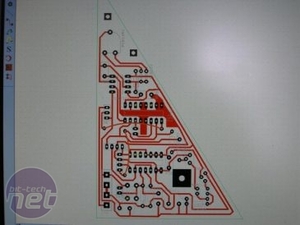Internal Design and Components
I eventually hit on the idea of motorising one of the pyramid's side panels and adding a 5in LCD screen so that the panel hides the display. Rather than going straight to pen, paper and rendering, my first designs were actually made up in my mind. It had to be a small PC that would fit on a small table such as a coffee table. Initially I wanted the base to be 30 x 30cm.Once I'd gathered information on possible hardware options, such as mini-ITX motherboards, slim optical drives and the like, this proved a little too ambitious, so I enlarged the design a bit and went for a 35 x 35cm base - still small, but much easier to work with.
For the hardware, I used a COMMELL LV-677, which is an LGA775 mini-ITX motherboard. I decided to use an Intel Dual Core T7200 CPU and a GeForce 9400GT graphics card, as I wouldn't be doing any serious gaming, and for storage I opted for a 2.5in 160GB laptop hard disk.
Initially I planned to build the PC in around three months, as it didn't seem particularly hard to do. I was in for a big surprise. I built the basic frame fairly quickly, using an aluminum bottom plate and aluminum strips with hinges to make the familiar angles of the pyramid shape. For the side-mounted display I used a PSONE screen, as these are widely used in the modding scene and have a good reputation.
I then moved on to the motorised side-panel, which lifts over the display. To keep the costs to a minimum, I decided to use the mechanical parts from an optical drive to lift the panel. This wasn't as straightforward as it sounds, though, and I ended up tearing apart about 10 drives to find the right parts for the job. The idea was to use two pivots and the motorised part, which would lift one side of the pyramid.
As usual, thinking about it and actually getting it to work are completely different. Building the motorised side-panel became a prolonged case of trial and error thanks to design errors in the mechanics. I also discovered that I needed some horizontal movement as well as vertical movement so as not to foul other parts of the case.
Eventually, with the help of bit-tech forum members, I solved the problem by using a guiding system. I had to replace the optical drive motor with a transmission motor because it wasn't powerful enough to deal with the weight.
Then I encountered another problem. The upward movement was pretty slow but the downward movement was fast due to the weight of the side panel - gravity, in other words. The solution came to me after a couple of beers: I'd use the same mechanism a lift uses - contra weights.
As there is no standard hardware for controlling the motor and the screen, I built the controllers myself with information gathered from the web. Electronics used to be a hobby of mine, so it was nice to get back into it and get my hands dirty.

MSI MPG Velox 100R Chassis Review
October 14 2021 | 15:04

















Want to comment? Please log in.